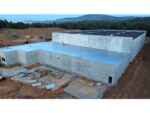The Massachusetts Institute of Technology (MIT), in collaboration with leading maritime and nuclear stakeholders, has released the “Nuclear Ship Safety Handbook” — a landmark document aimed at guiding the safe integration of nuclear propulsion into the civilian maritime sector. The handbook addresses regulatory gaps and operational safety considerations as interest grows in using small modular reactors (SMRs) for commercial shipping decarbonization.
Background: Rising Interest in Civilian Nuclear Propulsion
As global shipping faces mounting pressure to decarbonize under International Maritime Organization (IMO) targets and EU emissions regulations, nuclear propulsion is re-emerging as a serious candidate for zero-emission long-range shipping. While naval vessels have employed nuclear reactors for decades — notably submarines and aircraft carriers — the commercial sector has largely avoided it due to safety concerns, regulatory ambiguity, and public perception.
Recent advances in small modular reactor (SMR) technology, combined with the need for energy-dense alternatives to fossil fuels like heavy fuel oil (HFO), have revived interest in nuclear-powered merchant ships. Several countries and companies are exploring designs for container ships, tankers, and icebreakers powered by SMRs or microreactors. However, a lack of standardized safety frameworks has hindered progress.
The MIT Maritime Nuclear Innovation Consortium
The newly published handbook is the product of the Maritime Nuclear Innovation Consortium (MNIC), led by MIT’s Center for Advanced Nuclear Energy Systems. The consortium includes stakeholders from academia (MIT), classification societies (Lloyd’s Register), ship operators (Maersk), engineering firms (DNV), national labs (Idaho National Laboratory), and regulators such as the U.S. Department of Transportation’s Maritime Administration (MARAD).
According to Dr. Jacopo Buongiorno, professor of nuclear science at MIT and co-chair of MNIC, “The goal is to enable safe deployment of advanced reactors on commercial vessels by providing practical guidance grounded in both naval reactor experience and modern risk-informed methodologies.”
Scope and Structure of the Nuclear Ship Safety Handbook
The 93-page handbook provides a comprehensive framework addressing design principles, risk assessment methodologies, emergency response planning, radiation protection measures aboard ships and in ports, crew training requirements, waste handling protocols, accident scenarios including loss-of-coolant events at sea or in port environments, cybersecurity threats specific to reactor control systems aboard vessels, and more.
Key features include:
- Risk-Informed Design: Emphasis on probabilistic risk assessment (PRA) tailored for maritime environments.
- Defense-in-Depth: Layered safety systems modeled after naval reactor designs but adapted for commercial use.
- Port Interface Protocols: Guidelines for port authorities on how to safely host nuclear-powered ships.
- Crew Licensing & Training: Recommendations aligned with both IMO STCW standards and U.S. NRC practices.
- SAR & Emergency Response Integration: Coordination with coast guards and regional emergency services.
The handbook also includes case studies from past civilian applications such as the NS Savannah — America’s only nuclear-powered merchant ship — as well as insights from Russian icebreaker operations using KLT-40S reactors.
Navigating Regulatory Gaps Across Jurisdictions
A major barrier to deploying civil nuclear marine power lies in fragmented or absent regulatory frameworks. Unlike land-based reactors governed by national regulators like the U.S. NRC or IAEA guidelines internationally, there is no unified international regime specifically governing marine-based civilian reactors operating across exclusive economic zones (EEZs).
The handbook proposes harmonizing safety standards through cooperation between IMO member states and leveraging existing classification society rulesets augmented by IAEA safety fundamentals. It also suggests establishing flag-state oversight protocols that include reactor-specific audits during vessel certification processes — potentially under SOLAS Chapter VIII extensions or new annexes specific to floating reactors.
Civil-Military Technology Transfer Considerations
A notable dimension of this initiative is its reliance on lessons learned from military naval propulsion programs while ensuring that sensitive technologies remain protected under ITAR/export control regimes. The handbook explicitly avoids disclosing classified reactor designs but draws heavily on operational best practices from U.S., UK Royal Navy, French Navy (Marine Nationale), Russian Northern Fleet experience with icebreakers/submarines where applicable.
This reflects a growing trend where dual-use technologies — such as compact heat exchangers or passive decay heat removal systems — are being adapted from military platforms into civil applications via public-private partnerships without compromising national security protocols.
Industry Implications: Decarbonization Meets Strategic Autonomy
If adopted widely, marine SMRs could reshape global shipping economics by enabling ultra-long endurance voyages without refueling while eliminating greenhouse gas emissions entirely during operation. This aligns closely with NATO-aligned nations’ strategic goals around energy independence at sea while reducing reliance on bunker fuel supply chains vulnerable to disruption during conflict or sanctions scenarios.
For shipbuilders and classification societies like ABS or Bureau Veritas considering futureproof designs beyond LNG dual-fuel systems or methanol retrofits — integrating modularized reactor compartments could offer long-term value propositions despite higher upfront CapEx costs offset by fuel savings over decades-long vessel lifecycles.
Next Steps: Pilot Projects & International Engagement
The MNIC plans follow-up initiatives including pilot demonstration projects involving barge-based floating power units or retrofitted cargo vessels operating within controlled EEZs such as Alaska’s Aleutians or Nordic Arctic routes under close regulatory supervision. These projects would test real-world operability while validating handbook assumptions around crew proficiency needs and emergency response latency metrics at sea versus port scenarios.
MNIC also seeks engagement with IMO working groups on alternative fuels under MEPC committees to formalize recognition pathways for marine SMRs within MARPOL Annex VI compliance regimes. Engagements are underway with Japan’s Ministry of Land Infrastructure Transport & Tourism (MLIT), South Korea’s KRS classification body, Canada’s CNSC regulator for Arctic shipping corridors using floating microreactors in remote communities.
Conclusion: A Foundational Step Toward Zero-Carbon Ocean Transport
The release of MIT’s “Nuclear Ship Safety Handbook” marks a foundational step toward mainstreaming civil marine nuclear propulsion within global maritime decarbonization strategies. While significant regulatory hurdles remain ahead — particularly concerning liability conventions like Paris/Brussels protocols not yet adapted for mobile platforms — this document provides an actionable blueprint grounded in technical rigor that can accelerate policy convergence across industrialized nations seeking secure zero-carbon transport modalities at scale.









